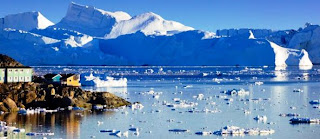 |
| (pik-postdam.de) |
The scientists from the institute, using the new computer simulations for Greenland ice sheets and regional climate. This model performs calculations of these physical systems including the most important processes, for instance climate feedbacks associated with changes in snowfall and melt under global warming. The simulation proved able to correctly calculate both the observed ice-sheet of today and its evolution over previous glacial cycles
The time it takes before most of the ice in Greenland is lost strongly depends on the level of warming. “The more we exceed the threshold, the faster it melts,” says Alexander Robinson, lead-author of the study now published in Nature Climate Change. In a business-as-usual scenario of greenhouse-gas emissions, in the long run humanity might be aiming at 8 degrees Celsius of global warming. This would result in one fifth of the ice sheet melting within 500 years and a complete loss in 2000 years, according to the study. “This is not what one would call a rapid collapse,” says Robinson. “However, compared to what has happened in our planet’s history, it is fast. And we might already be approaching the critical threshold.”
In contrast, if global warming would be limited to 2 degrees Celsius, complete melting would happen on a timescale of 50.000 years. Still, even within this temperature range often considered a global guardrail, the Greenland ice sheet is not secure. Previous research suggested a threshold in global temperature increase for melting the Greenland ice sheet of a best estimate of 3.1 degrees, with a range of 1.9 to 5.1 degrees. The new study’s best estimate indicates about half as much.
“Our study shows that under certain conditions the melting of the Greenland ice sheet becomes irreversible. This supports the notion that the ice sheet is a tipping element in the Earth system,” says team-leader Andrey Ganopolski of PIK. “If the global temperature significantly overshoots the threshold for a long time, the ice will continue melting and not regrow – even if the climate would, after many thousand years, return to its preindustrial state.” This is related to feedbacks between the climate and the ice sheet: The ice sheet is over 3000 meters thick and thus elevated into cooler altitudes. When it melts its surface comes down to lower altitudes with higher temperatures, which accelerates the melting. Also, the ice reflects a large part of solar radiation back into space. When the area covered by ice decreases, more radiation is absorbed and this adds to regional warming.
This article has edited by authors of threelas
Publication: Nature Climate Change
Post a Comment